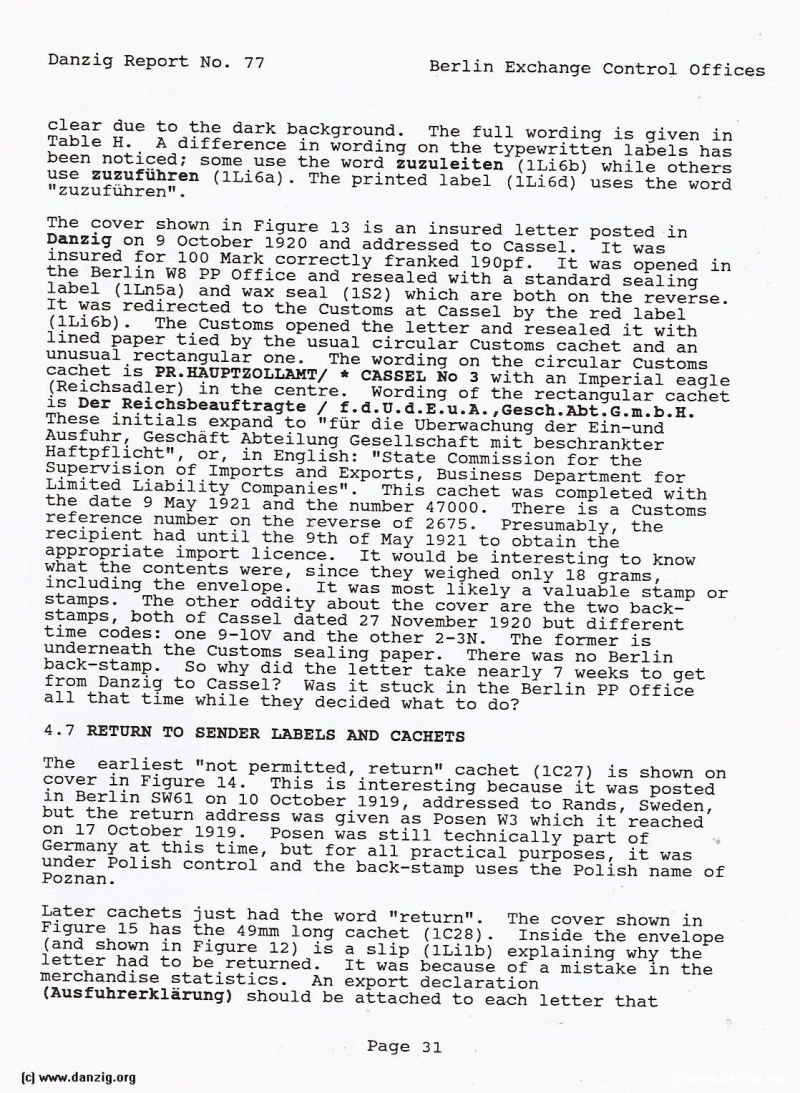
clear due to the dark background. The full wording is given in Table H. A difference in wording on the typewritten labels has been noticed; some use the word zuzulejten (lLi6b) while others use zuzuführen (lLi6a). The printed label (lLi6d) uses the word “zuzuführen”.
The cover shown in Figure 13 is an insured letter posted in Danzig on 9 October 1920 and addressed to Cassel. It was insured for 100 Mark correctly franked l9opf. It was opened in the Berlin W8 PP Office and resealed with a standard sealing label (lLn5a) and wax seal (1S2) which are both on the reverse. It was redirected to the Customs at Cassel by the red label (lLi6b). The Customs opened the letter and resealed it with lined paper tied by the usual circular Customs cachet and an unusual rectangular one. The wording on the circular Customs cachet is PR.HAUPTZOLLANT/ * CASSEL No 3 with an Imperial eagle (Reichsadler) in the centre. Wording of the rectangular cachet is Der Reichsbeauftragte / f.d.U.d.E.u.A.,Gesch.t.G.m.b.R These initials expand to “für die Uberwachung der Ein-und Ausfuhr, Geschäft Abteilung Gesellschaft mit beschrankter Haftpflicht”, or, in English: “State Commission for the Supervision of Imports and Exports, Business Department for Limited Liability Companies”. This cachet was completed with the date 9 May 1921 and the number 47000. There is a Customs reference number on the reverse of 2675. Presumably, the recipient had until the 9th of May 1921 to obtain the appropriate import licence. It would be interesting to know what the contents were, since they weighed only 18 grams, including the envelope. It was most likely a valuable stamp or stamps. The other oddity about the cover are the two back- stamps, both of Cassel dated 27 November 1920 but different time codes: one 9-lOV and the other 2-3N. The former is underneath the Customs sealing paper. There was no Berlin back—stamp. So why did the letter take nearly 7 weeks to get from Danzig to Cassel? Was it stuck in the Berlin PP Office all that time while they decided what to do?
4.7 RETURN TO SENDER LABELS AND CACHETS
The earliest “not permitted, return” cachet (1C27) is shown on cover in Figure 14. This is interesting because it was posted in Berlin SW61 on 10 October 1919, addressed to Rands, Sweden, but the return address was given as Posen W3 which it reached on 17 October 1919. Posen was still technically part of Germany at this time, but for all practical purposes, it was under Polish control and the back—stamp uses the Polish name of Poznan.
Later cachets just had the word “return”. The cover shown in Figure 15 has the 49mm long cachet (1C28). Inside the envelope (and shown in Figure 12) is a slip (lLilb) explaining why the letter had to be returned. It was because of a mistake in the merchandise statistics. An export declaration (Ausfuhrerklarung) should be attached to each letter that
Danzig Report Vol. 1 - Nr. 77 - October - November - December - 1992, Page 31.
Hits: 1380
Added: 03/07/2015
Copyright: 2024 Danzig.org

